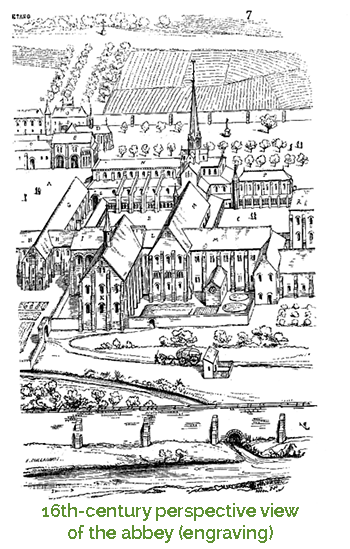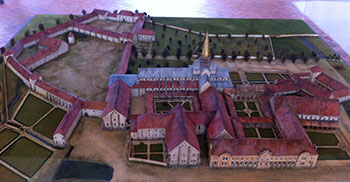

 Citeaux Abbey was founded in 1098 by a small group of monks who wanted to create a new monastic community which closely followed the Rule of St. Benedict (see History, Cistercian Monks). It is located in the Saone Valley, Burgundy, France.
Citeaux Abbey was founded in 1098 by a small group of monks who wanted to create a new monastic community which closely followed the Rule of St. Benedict (see History, Cistercian Monks). It is located in the Saone Valley, Burgundy, France.
The location that the monks arrived at was a remote deserted swamp and forest area, which the monks worked to cultivate.
From small beginnings, the Cistercian movement grew rapidly and there were over 500 houses during the early 13th century. In order to maintain unity and uniformity in the Cistercian way of life and worship, the Abbot of each Mother House in Europe travelled to Citeaux to attend the Annual General Chapter around Holy Cross Day on 14 September of each year. This olden day equivalent of an AGM was an event at which Cistercian legislation, disciplines and penalties were set down. These rules were laid down in the Cistercian constitution named the ‘ Charter of Love’. After he had attended the General Chapter, the Abbot of each Mother House then visited his Daughter Houses in order to inspect life there and to pass on the Charter.
The community and buildings at Citeaux suffered fire and pillaging during the first two hundred years of it’s existence, reducing Citeaux to poverty on each of these occasions. During the 13th to 14th centuries Citeaux prospered due to agricultural efforts and success. Citeaux owned various granges / domains within a 25 km diameter of the abbey. Lay brothers lived at these granges and worked the land as well as excelling in animal husbandry, fish farming, wine growing, forging, and mastering the use of hydraulics with canals and mills. Some granges were run by tenant farmers with links to the abbey providing funding.
 At the end of the 15th century a library was constructed at Citeaux. Numerous religious manuscripts were written here. Over 300 of them can be viewed at the Dijon municipal library today.
At the end of the 15th century a library was constructed at Citeaux. Numerous religious manuscripts were written here. Over 300 of them can be viewed at the Dijon municipal library today.
The 16th century saw destruction and hardship at Citeaux. The monastery and its domains were pillaged again and devastated by mercenaries on several occasions due to political and religious unrest in Europe.
During the 17th century the Church in Europe experienced a revival. This prompted the revision of, and a renewed vigour in, the following of the Rule of St Benedict at Citeaux, after the abandonment of some practices.
The early 18th century saw prosperity again, with a more modern approach. Workshops were created in the infirmary in order to provide work for the unemployed in the area, and the start of a major architectural overhaul began. The French Revolution put an end to these renovations as the monks left Citeaux.
Citeaux was sold to speculators in the late 18th century as national property, and was soon dismantled. It became a rock quarry, then a sugar factory, then an agricultural community for under-privileged youth.
 The domain and buildings of Citeaux were re-acquired by the Cistercian Order in 1898, exactly 800 years after its foundation. During the 19th and 20th centuries monks returned to Citeaux in order to re-build the community. The monastery was used as a hospital during the First World War, but soon after transformed once again into a productive and stable Cistercian community.
The domain and buildings of Citeaux were re-acquired by the Cistercian Order in 1898, exactly 800 years after its foundation. During the 19th and 20th centuries monks returned to Citeaux in order to re-build the community. The monastery was used as a hospital during the First World War, but soon after transformed once again into a productive and stable Cistercian community.
Today, Citeaux Abbey is owned by the Order of Cistercians of the Strict Observance. It is a working monastery with approximately 35 members who are faithful to the tradition of manual work, and silence. The monks produce the popular Citeaux cheese as well as honey, sweets and caramels, and sell to the general public.
Citeaux Abbey is open to the general public.